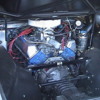I bought this to use as a poor mans pre-oiler to be used to pressurize the oil before starting the engine, thus eliminating dry starts. The unit has an internal Oring sealed piston that can travel smoothly from end to end depending on the pressure differnce. I plan to fill one side with oil and replace the manual valve shown with an elictric soliniod valve that I can operate from inside the car. The oil pressure sending unit will have a T put under it so I can inject the oil in that port.When I start the engine oil pressure will compress the air on the other side of the internal piston because the solinois valve will be open. After pressure builds on the air side I will close the valve and contain the pressurized oil inside ...untill the next time I start it. When I open the valve and watch the oil pressure gauge go up before I turn the motor over. What do think? Is the sending unit port as good a place as any?
Attachments
Original Post


